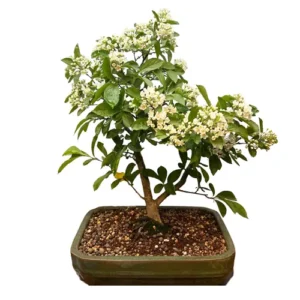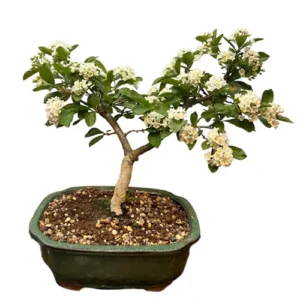Rosa
Rose Bonsai
Maybe the most famous and popular flower in the world, Rosa as a genus has around 250 species to its name. Colourful, wonderfully scented and easy to grow, Rose make for imaginative bonsai too. Along with their iconic flowers, Rosa can develop thick, distinctive trunks.
Rose Bonsai Care Tips
Placement
Choose an outdoor spot that will suitably aerate the plant and provide full sun. Partial shade is also applicable for the summer. Rose Bonsai are hardy but will need some winter protection in a cool and frost-free location.
Watering
If placed in the sun, Rose bonsai requires lots of water throughout the growing season. It is vital to not let it dry out entirely and to keep it moist. Water with a 6.5 to 7 pH value wouldn’t go amiss. Tap water is applicable if yours is particularly calcium-rich.
Feeding & Fertilising
Across the growing season use a solid organic feed once a month. Alternatively, liquid feed can be used weekly. Should the leaves turn pale an extra iron fertiliser is advised.
Pruning & Wiring
Pruning your bonsai is important not only to create or maintain an aesthetic style but to also ensure optimal health. Prune in early spring before the new buds swell. Allow any shoots to grow so the flowers can develop. Rose hips can be removed by timing back new shoots after flowering to keep a compact tree shape.
Rose Bonsai does not necessarily require wiring as most shaping can be achieved through pruning. Beware of the sharp pines when wiring, young branches will respond well, but old branches require much more care. We recommend using wires with a thickness that matches the thickness of the branch: if the wire you choose is too thick you will damage the bark. If it is too thin, it won’t be effective.
Repotting
Repotting your tree is an important way to provide a fresh and suitable soil mix and ensure appropriate root health. Rose Bonsai trees require repotting every two to three years when young. Older Rose Bonsai can be repotted less frequently. The roots of this specimen are responsive to root pruning.
Trees that are ready for repotting will require root pruning, a suitable new pot and appropriate soil mix.
When repotting, do not cut back the root mass by a large amount, and choose a well-draining soil mix that has a neutral or slightly higher PH value of 5-6 but not over 7. We tend to use a mixture of different speciality bonsai soils on our trees. Every species is different so please contact us for free soil-mix advice or to take advantage of our repotting service.
Bonsai trees aren’t only magnificent additions to an indoor oasis, they are more than capable of standing out in any garden. Many Bonsai species are incredibly hardy and withstand nature’s colder and damper turns with aplomb making them worthwhile outdoor plants. We have an extensive library of care guides for outdoor bonsai trees. It’s not about selecting the perfect bonsai, it’s about selecting the perfect bonsai for you.
Rose Bonsai - Typical Queries
How to propagate Rose bonsai?
Rose Bonsai are easily propagated. The most trusted and popular method is with cuttings in the summer. It’s best to use one year old shoots that have hardened off.
Are Rose bonsai prone to pests and diseases?
As the world’s most famous flower, Roses are also very popular with pests and insects. This species is susceptible to invasion from rose midges, thrips, sawfly, lead cutter bees, Japanese beetles, aphids, spider mites and scale… just to name a few. Using appropriate insecticides can take care of these.
Fungal diseases that can affect Roses include stem cankers, botrytis blight, powdery mildew and black spots.
Is Rose bonsai good for beginners?
Absolutely. Part of the charm of Rose bonsai is that just about anyone can grow one quite easily. Old garden specimens can be used to create your very own rose bonsai.





















